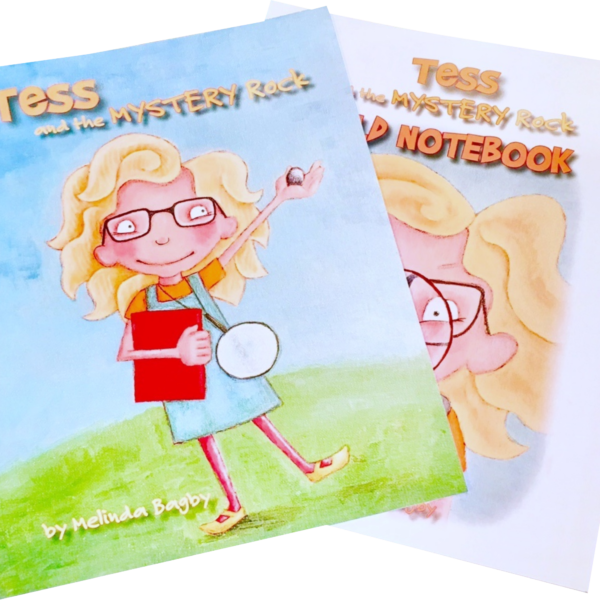Tess and The Mystery Rock by Melinda Bagby teaches science through a delightful 47-page story with marvelous illustrations by Jane Gross. This storybook weaves science into literature and can be used on its own or along with its companion field guide.
In the storybook, we meet Tess, a young girl who loves to ask questions about everything. Her mom gives her a journal to write down some of her questions and observations.
On the way to school one day, a rock that had bounced out of a truck accidentally strikes Tess. She thinks it came from the sky and decides it must be a meteorite. She takes it to school to check with her teacher, but before she can do so her classmate Leo grabs the rock away from her. Her teacher, Miss Anna, discovers what is going on, then helps Tess and her classmates figure out what type of rock it is.
In the book, the story is interrupted by occasional observations that Tess records as she learns to think scientifically. Before Miss Anna breaks the rock open, a “Thought Stop” page presents some information comparing various types of earth rocks and space rocks. “Think About It” questions on the next page help students think like a scientist, observing, asking questions, and coming up with hypotheses. After reading this information and thinking it through, students are challenged to answer the question, “Do you think Tess found a meteorite? Why or why not?”
A second Thought Stop a few pages further into the story teaches the scientific method more directly. Then the next Think About It section asks students to come up with their own hypothesis as to what they will find inside the rock and draw a picture of that. The next two pages continue with a hypothetical experiment. On one page, students write about what they think they will observe inside the rock. On the next page, students write down what observations they should be able to make about the rock and how they could go about making those observations. They "imagine" results for this experiment then consider whether or not those results will support the student’s original hypothesis. None of this requires actual experimentation.
In a third Thought Stop, students now know that Tess’s rock is a geode rather than a meteorite, so they compare their hypothesis to this fact. They also compare characteristics of geodes and meteorites. After the story concludes, the book adds a page each on topics from biology, astronomy, physics, geology, and chemistry as well as a glossary.
While the storybook can stand on its own and includes space for students to write and draw, the Tess and the Mystery Rock Field Notebook expands it into a more comprehensive science unit study that can be done in only a few weeks. You can also use both components of Tess and the Mystery Rock along with the kindergarten level book in the Exploring the Building Blocks of Science series.
While the storybook is printed in full color, the 40-page Field Notebook is black and white. Some pages in the Field Notebook are duplicated from the storybook (but in black and white), and these include all pages on which students might write as well as some informational pages. The Field Notebook adds additional pages about the moon, trees, and gravity. Students will make observations and come up with their own questions, thoughts, and hypotheses for these other topics, just as in the storybook. But the Field Notebook goes further. Students draw pictures of their observations of the moon for several days or weeks. They go on a nature walk looking for rocks which they will draw in their Field Notebook, and they compare and contrast rocks they find. They will perform two hands-on experiments by creating their own geode and testing the speed of falling objects.
For a homeschooling family, you might have one storybook that you read aloud to everyone, then give each student a Field Notebook in which they will do all of their writing, drawing, and recording of information. Tess and the Mystery Rock was written for students in kindergarten through fourth grade, so younger students will need assistance in writing their thoughts while older students should be able to do this themselves.
Children are likely to enjoy the storybook aspect of Tess and the Mystery Rock even aside from the value of this mini-course for teaching science. In addition, both the storybook and the Field Notebook offer a gentle way to introduce the scientific method as they encourage students to make observations and come up with their own questions and ideas.








